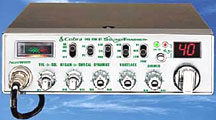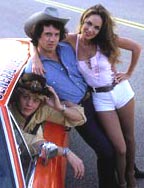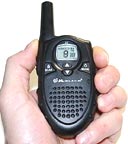Tuesday 3 January, 2006, 16:50 - Radio Randomness
Citizens' Band (CB) Radio began in the UK in the late 1970's when truckers and a few other enthusiasts (illegally) imported CB radios from the USA where they were widely available and relatively low cost.  Prices for these illegal AM sets in the UK were typically around GBP50 which wasn't totally out of reach of even a few school kids. I fondly remember communicating via CB with many of a my school friends whose parents would surely have been worried if they'd known the penalties for operating the equipment!
Prices for these illegal AM sets in the UK were typically around GBP50 which wasn't totally out of reach of even a few school kids. I fondly remember communicating via CB with many of a my school friends whose parents would surely have been worried if they'd known the penalties for operating the equipment!Under immense populist pressure, the UK government finally relented and on 2 November 1981 the Radiocommunication Agency licensed CB radio of two flavours. CB in America (and in most other countries which had licensed it) operated on 40 channels spread out between 26.965 and 27.405 MHz. The UK decided that, as CB radio was meant to be a local communications service, it would license a different set of channels to stop UK 'breakers' from chatting to overseas CBers when conditions permitted - thus 40 channels from 27.60125 to 27.99125 were licenced with a maximum power of 4 watts and a maximum antenna size of 1.5 metres and height of 10 metres above the ground (these antenna restrictions have since been relaxed). Equipment (marked 'CB 27/81') for the band was readily available from day one at prices similar to the illigaly available US equipment.
In addition to the 27 MHz channels, an additional 20 channels were licensed in the frequency range 934.0125 - 934.9625 MHz. The 934 MHz band was mainly for enthusiasts as equipment was relatively cutting edge and hence expensive and operation required a great deal of skill. A licence fee of GBP10 per year (now GBP15) was payable to use either (or both) bands, though many users, having been used to operating illegally, never bothered with this formailty.
In 1988 the Radiocommunications Agency succumbed to pressure from Europe and licensed the US 27 MHz channels (which had been formally adopted by CEPT for use across Europe). At the same time the withdrawal of the 934 MHz band (at the end of 1998) was announced to make way for GSM phones, and the use of the original UK-only 27 MHz channels was frozen with no new equipment allowed to be manufactured in favour of the CEPT channels.
 With the ready availability of equipment and the boosted awareness of CB amongst the general population through films such as 'Convoy' and 'Smokey and the Bandit' and TV shows such as 'The Dukes of Hazzard', the CB channels quickly became the playground for every kind of nutter you could imagine. Many channels were filled with the likes of frustrated DJ's who would spend hours playing music from their bedrooms and people who thought that swearing incessantly on the calling channel represented sport. Towards the end of the 1980's CB usage began to wane and today, even in a highly populated area such as London a tune across the 40 UK and 40 CEPT CB channels yields very little usage. Also, 27 MHz is not an ideal frequency for local communications. At certain times of the year, especially in the summer, propagation allows communication over 1000's of km and channels become clogged as it becomes easier to talk to breakers from faraway places such as Italy and Russia than to talk to people only a few km away.
With the ready availability of equipment and the boosted awareness of CB amongst the general population through films such as 'Convoy' and 'Smokey and the Bandit' and TV shows such as 'The Dukes of Hazzard', the CB channels quickly became the playground for every kind of nutter you could imagine. Many channels were filled with the likes of frustrated DJ's who would spend hours playing music from their bedrooms and people who thought that swearing incessantly on the calling channel represented sport. Towards the end of the 1980's CB usage began to wane and today, even in a highly populated area such as London a tune across the 40 UK and 40 CEPT CB channels yields very little usage. Also, 27 MHz is not an ideal frequency for local communications. At certain times of the year, especially in the summer, propagation allows communication over 1000's of km and channels become clogged as it becomes easier to talk to breakers from faraway places such as Italy and Russia than to talk to people only a few km away.So is CB radio dead? Well in its original format, possibly. The new UK regulator, Ofcom, has allowed an experiment called the 'Community Audio Distribution System (CADS)' in the 27 MHz band to try and make use of these otherwise empty channels. Meanwhile, in April 1999, Ofcom de-regulated a set of frequencies in the range 446.00625 to 446.09375 for a service called 'PMR446'. PMR446 was a replacement for the previous 'Short Range Business Radio (SRBR)' service which allowed the use of 3 channels at 461 MHz at low power for just GBP30 per annum and was intended to be used by businesses whose radio requirements did not merit a wider-area licence (such as between shop assistants in department stores). However, being licence-exempt, the PMR446 service soon found favour amongst a variety of radio users who might otherwise have used CB. Eight channels are available and equipment is restricted to 500 mW of power and integral antennas, however reliable ranges of around 1km are common.
 Thus those who want to use radio for non-commercial use such as families and event organisers have access to channels which are largely, though not exclusively, idiot-free and that do not suffer from frequent continental interference. PMR446 is an analogue service, however having regocnised its potential, a digital version of PMR446 which should supposedly offer greater range and better audio quality is already on the cards.
Thus those who want to use radio for non-commercial use such as families and event organisers have access to channels which are largely, though not exclusively, idiot-free and that do not suffer from frequent continental interference. PMR446 is an analogue service, however having regocnised its potential, a digital version of PMR446 which should supposedly offer greater range and better audio quality is already on the cards. Where does this leave CB then? With 27 MHz mostly dead and most 'community' use of radio now using the short-range PMR446 service, there is still a need for a wider area CB type service to replicate the service offered by CB for businesses such as taxi's and logistics companies. Help may be at hand in the form of the little recognised 'UK General' licence. This allows the use of a number of VHF and UHF frequencies with 5 Watts of power (10 times more than PMR 446), however a licence fee of GBP60 every 3 years is payable. The frequencies which can be used are:
77.6875 MHz
86.3375 MHz
86.3500 MHz
86.3625 MHz
86.3750 MHz
164.0500 MHz
164.0625 MHz
169.0875 MHz
169.3125 MHz
173.0625 MHz
173.0875 MHz
173.0500 MHz
449.3125 MHz
449.4000 MHz
449.4750 MHz
A quick scan of this odd collection of channels in West London shows that many are relatively unoccupied and would offer great potential for a supplemental service to PMR446. A more sensible pricing regime for the use of these frequencies (say GBP15 per annum...) or indeed the inclusion of these channels in the UK CB licence might just tip the balance back in favour of CB radio as a sensible solution to the radio needs of small businesses.
4 comments
( 3101 views )
| permalink
| 



 ( 2.9 / 14688 )
( 2.9 / 14688 )




 ( 2.9 / 14688 )
( 2.9 / 14688 )

